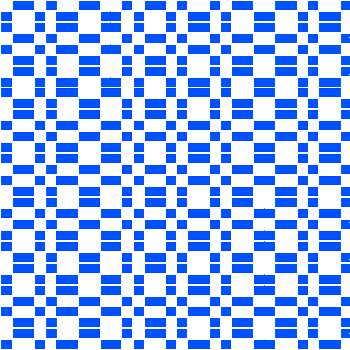The Thue–Morse Constant
October 25, 2013
The most useful, and probably the most beloved,
mathematical constant is
pi (π). Pi is even celebrated as a
holiday,
Pi Day, March 14, since 3-1-4 are the three most significant
decimal digits of pi.[1] As I wrote in a
previous article (The Circle Ratio, April 12, 2013), pi is sometimes called
Archimedes' constant, since the
Greek mathematician,
Archimedes, produced a good estimate of its value by
inscribing and
circumscribing regular polygons in and around a
circle.

Archimedes is famous also for his Eureka! moment. While in a bath, he realized that the volume of water displaced by a submerged object was equal to the volume of that object.
(Colored woodcut on paper, 1547, by Johann Petrejus, from the Deutsche Fotothek collection, via Wikimedia Commons.)
Wikipedia has a
list of common mathematical constants. Without counting
reciprocals, there are still quite a few constants with a value less than one. Perhaps some
number theorist will one day prove that the number of mathematical constants less than one is equal to the number greater than one. If we allow reciprocals, that would be a certainty.
Here are five of the more easily described mathematical constants with a value less than one:
• 0.26149 72128 47642...
Meissel–Mertens constant (M
1). This is the
limit of the difference between the
harmonic series summed over the
primes, only, and the
natural logarithm of the natural logarithm. That last part always reminds me of
Boss Hogg's percentage cut to
Sheriff Rosco P. Coltrane, "ten percent of ten percent," in the
Dukes of Hazzard television series.
• 0.56714 32904 09783..., the
Omega constant (Ω). The Omega constant is defined by the
equation,
ΩeΩ = 1.
• 0.57721 56649 01532..., the
Euler–Mascheroni constant (γ), is the limit of the difference between the harmonic series and the natural logarithm, so it's related to the Meissel–Mertens constant. It's larger, since the harmonic series sums the reciprocals of all positive integers, and not just the prime numbers.
• 0.66016 18158 46869..., the
Twin prime constant (C
2), is defined as the product of the following for p being a prime number greater than two:
[p(p-2)]/[(p-1)2]
• 0.87058 83800 (approximately),
Brun's constant (B
4), is the sum of the reciprocals of the
twin primes.
As you've guessed by now, prime numbers are a recurrent theme in
number theory. When you search
arXiv for
mathematics papers whose titles contain "prime" or "primes," you get this message: "Your query resulted in too many hits, only 1000 hits are being displayed."
The above constants are legitimate mathematical constants, since they represent solutions to formal
conjectures. It's easy to manufacture a mathematical constant less than one by placing a
decimal point in front of one of the many
integer sequences in the
On-Line Encyclopedia of Integer Sequences (OEIS).
The
Champernowne constant in
base 10,
0.12345 67891 01112 13141 51617...,
is built in such a way. If you haven't yet guessed it, this constant is formed by placing a decimal point in front of the
positive integers. The individual decimal digits forming the Champernowne constant are sequence
A033307 in the OEIS. Likewise, there's a Champernowne constant in
base-2,
0.11011 10010 11101...
The
Thue-Morse sequence (
OEIS A010060) is especially understandable to
computer scientists, since it involves the
two's complement of numbers. Two ways in which this constant can be defined are as follow:
1) Start with a string that's just the single character 0, and repeatedly apply the replacement rules 0 -> 01 and 1 -> 10 to the characters of the string.
2) Start with a string that's just the single character 0, and repeatedly append the binary complement of the string to itself; that is, repeatedly concatenate copies of the string in which all ones have become zeros, and all zeros have become ones.
Not surprisingly, there's a lot of
symmetry in such a number when it's viewed in chunks that are powers of two in length, as shown in the following figure. This figure was generated from a file created by my own program for generating the Thue-Morse sequence. The
source code for the program can be found
here.

A graphical representation of the Thue-Morse sequence in which ones are represented as blue boxes in a 32x32 square.
The numbers were calculated by the author's program and mapped using a word processing program.
(Illustration by the author using LibreOffice)
The Thue–Morse sequence can be manufactured into a
Thue-Morse Constant with value
0.01101 00110 01011... (base-2)
0.41245 40336 40107... (base-10)
The Thue-Morse sequence might not be mathematically important, but it illustrates how a very simple rule can generate some interesting results. Another example is the
logistic map.
References:
- The US House of Representatives, in its 2009-2010 session (the 111th Congress), passed a resolution supporting March 14 as Pi Day on March 12, 2009. The text of the resolution contains the following:
"...Whereas Pi can be approximated as 3.14, and thus March 14, 2009, is an appropriate day for ''National Pi Day'':
Now, therefore, be it Resolved, That the House of Representatives-(1) supports the designation of a ''Pi Day'' and its celebration around the world..."
The full text of the resolution (H.Res. 224) can be found here.
- Eric W. Weisstein, "Thue-Morse Constant," From MathWorld--A Wolfram Web Resource
Permanent Link to this article
Linked Keywords: Mathematical constant; pi; holiday; Pi Day; decimal digit; Greek; mathematician; Archimedes; circumscribed circle; inscribed; tangential polygon; circumscribed; regular polygon; circle; Eureka effect; Eureka! moment; bathtub; bath; volume; water; displacement; Deutsche Fotothek; Wikimedia Commons; Wikipedia; list of common mathematical constants; multiplicative inverse; reciprocal; number theorist; Meissel–Mertens constant; limit of a function; limit; harmonic series; prime number; natural logarithm; Boss Hogg; Sheriff Rosco P. Coltrane; Dukes of Hazzard; Omega constant; equation; Euler–Mascheroni constant; twin prime constant; Brun's theorem; Brun's constant; twin prime; number theory; arXiv; mathematics; scientific literature; scientific paper; conjecture; decimal point; integer sequence; On-Line Encyclopedia of Integer Sequences; Champernowne constant; decimal; base 10; positive integer; OEIS A033307; binary number; base-2; Thue-Morse sequence; OEIS A010060; computer scientist; two's complement; string; concatenation; concatenate; symmetry; source code; graphical; blue; square; word processor; word processing; LibreOffice; Thue-Morse Constant; logistic map.